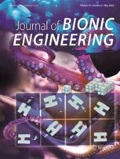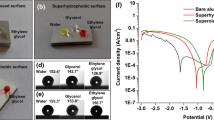Abstract
Although laser ablation is considered as a facile technique to fabricate bio-inspired super-hydrophobic surfaces, the issue is that the initial laser treated metallic surfaces show super-hydrophilic property. It will take a long period to reach super-hydrophobic state under ambient air. It is reported that these super-hydrophobic surfaces could be easily damaged by thermal heating effect or interaction with other liquids, causing uncontrolled loss of super-hydrophobicity. In this study, a stable super-hydrophobic aluminum surface was rapidly fabricated via the hybrid laser ablation and surface chemical modification of (heptadecafluoro-1, 1, 2, 2-tetradecyl) triethoxysilane (AC-FAS). Surface morphology and chemistry were systematically investigated to explore the generation mechanism of super-hydrophobicity. The water contact angle of the treated surfaces can reach up to 160.6° ± 1.5° with rolling angle of 3.0° ± 1.0°, exhibiting perfect self-cleaning capability, long-term stability, and excellent chemical stability in acidic as well as alkaline solutions. The potentiodynamic polarization tests implied that the super-hydrophobic surfaces showed better anti-corrosion performance. This hybrid laser ablation and surface chemical modification are very time-saving and low-cost, which offers a rapid way for quantity production of super-hydrophobic surface on aluminum material.
Similar content being viewed by others
References
Huhtamäki T, Tian X L, Korhonen J T, Ras R H A. Surface-wetting characterization using contact-angle measurements. Nature Protocols, 2018, 13, 1521–1538.
Barthlott W, Neinhuis C. Purity of the sacred lotus, or escape from contamination in biological surfaces. Planta, 1997, 202, 1–8.
Parker A R, Lawrence C R. Water capture by a desert beetle. Nature, 2001, 414, 33–34.
Gao X F, Jiang L. Water-repellent legs of water striders. Nature, 2004, 432, 36.
Gao X Y, Guo Z G. Biomimetic superhydrophobic surfaces with transition metals and their oxides: A review. Journal of Bionic Engineering, 2017, 14, 401–439.
Qi X, Song W, Mao Z, Gao W R, Cong Q. Fabrication of a bionic needle with both super-hydrophobic and antibacterial properties. Journal of Bionic Engineering, 2013, 10, 377–382.
Song Y, Liu Y, Zhan B, Kaya C, Stegmaier T, Han Z W, Ren L Q. Fabrication of bioinspired structured superhydrophobic and superoleophilic copper mesh for efficient oil-water separation. Journal of Bionic Engineering, 2017, 14, 497–505.
Trdan U, Hočevar M, Gregorčič P. Transition from superhydrophilic to superhydrophobic state of laser textured stainless steel surface and its effect on corrosion resistance. Corrosion Science, 2017, 123, 21–26.
Doll K, Fadeeva E, Stumpp N S, Grade S, Chichkov B N, Stiesch M. Reduced bacterial adhesion on titanium surfaces micro-structured by ultra-short pulsed laser ablation. BioNanoMaterials, 2016, 17, 53–57.
Hsieh C T, Chen J M, Kuo R R, Lin T S, Wu C F. Influence of surface roughness on water-and oil-repellent surfaces coated with nanoparticles. Applied Surface Science, 2005, 240, 318–326.
Yong J L, Chen F, Yang Q, Bian H, Du G Q, Shan C, Huo J L, Fang Y, Hou X. Oil-water separation: A gift from the desert. Advanced Materials Interfaces, 2016, 3, 1500650.
Bhushan B, Jung Y C. Natural and biomimetic artificial surfaces for superhydrophobicity, self-cleaning, low adhesion, and drag reduction. Progress Materials Science, 2011, 56, 1–108.
Feng L, Li S H, Li Y S, Li H J, Zhang L J, Zhai J, Song Y L, Liu B Q, Jiang L, Zhu D B. Super-hydrophobic surfaces: From natural to artificial. Advanced Materials, 2002, 14, 1857–1860.
Ellinas K, Tserepi A, Gogolides E. From superamphiphobic to amphiphilic polymeric surfaces with ordered hierarchical roughness fabricated with colloidal lithography and plasma nanotexturing. Langmuir, 2011, 27, 3960–3969.
Toosi S F, Moradi S, Ebrahimi M, Hatzikiriakos S G. Microfabrication of polymeric surfaces with extreme wettability using hot embossing. Applied Surface Science, 2016, 378, 426–434.
Steele A, Bayer I, Moran S, Cannon A, King W P, Loth E. Conformal ZnO nanocomposite coatings on micro-patterned surfaces for superhydrophobicity. Thin Solid Films, 2010, 518, 5426–5431.
Hwang S J, Oh D J, Jung P G, Lee S M, Go J S, Kim J H. Dry etching of polydimethylsiloxane using microwave plasma. Journal of Micromechanics and Microengineering, 2009, 19, 1489–1503.
Goto Y, Takashima H, Takishita K, Sawada H. Creation of coating surfaces possessing superhydrophobic and superoleophobic characteristics with fluoroalkyl end-capped vinyltrimethoxysilane oligomeric nanocomposites having biphenylene segments. Journal of Colloid Interface Science, 2011, 362, 375–381.
Yang Z, Liu X P, Tian Y L. Fabrication of super-hydrophobic nickel film on copper substrate with improved corrosion inhibition by electrodeposition process. Colloids and Surface A, 2019, 560, 205–212.
Cardoso J T, Garcia-Girón A, Romano J M, Huerta-Murillo D, Jagdheesh R, Walker M, Dimov S S, Ocaña J L. Influence of ambient conditions on the evolution of wettability properties of an IR-, ns-laser textured aluminium alloy. RSC Advances, 2017, 7, 39617–39627.
Chun D M, Ngo C V, Lee K M. Fast fabrication of superhydrophobic metallic surface using nanosecond laser texturing and low-temperature annealing. CIRP Annals-Manufacturing Technology, 2016, 65, 519–522.
Ta D V, Dunn A, Wasley T J, Kay R W, Stringer J, Smith P J, Connaughton C, Shephard J D. Nanosecond laser ablated superhydrophobic metallic surfaces and their chemical sensing applications. Applied Surface Science, 2015, 357, 248–254.
Kietzig A M, Hatzikiriakos S G, Englezos P. Patterned superhydrophobic metallic surfaces. Langmuir, 2009, 25, 4821–4827.
Long J, Zhong M, Zhang H, Fan P. Superhydrophilicity to superhydrophobicity transition of picosecond laser microstructured aluminum in ambient air. Journal of Colloid Interface Science, 2015, 441, 1–9.
Jagdheesh R, García-Ballesteros J J, Ocaña J L. One-step fabrication of near superhydrophobic aluminum surface by nanosecond laser ablation. Applied Surface Science, 2016, 374, 2–11.
Yang Z, Tian Y L, Yang C J, Wang F J, Liu X P. Modification of wetting property of Inconel 718 surface by nanosecond laser texturing. Applied Surface Science, 2017, 414, 313–324.
Yang C J, Mei X S, Tian Y L, Zhang D W, Li Y, Liu X P. Modification of wettability property of titanium by laser texturing. The International Journal of Advanced Manufacturing Technology, 2016, 87, 1663–1670.
Tian Y L, Zhao Y C, Yang C J, Wang F J, Liu X P, Jing X B. Fabrication of bio-inspired nitinol alloy surface with tunable anisotropic wetting and high adhesive ability. Journal of Colloid Interface Science, 2018, 527, 328–338.
Long J, Zhong M, Fan P, Gong D, Zhang H. Wettability conversion of ultrafast laser structured copper surface. Journal of Laser Applications, 2015, 27, S29107.
Boinovich L B, Emelyanenko A M, Emelyanenko K A, Domantovsky A G, Shiryaev A A. Comment on “nanosecond laser textured superhydrophobic metallic surfaces and their chemical sensing applications” by Ta D V, Dunn A, Wasley T J, Kay R W, Stringer J, Smith P J, Connaughton C, Shephard J D (Applied Surface Science, 2015, 357, 248–254.. Applied Surface Science, 2016, 379, 111–113.
Davaasuren G, Ngo C V, Oh H S, Chun D M. Geometric study of transparent superhydrophobic surfaces of molded and grid patterned polydimethylsiloxane (PDMS). Applied Surface Science, 2014, 314, 530–536.
Tang M K, Huang X J, Guo Z, Yu J G, Li X W, Zhang Q X. Fabrication of robust and stable superhydrophobic surface by a convenient, low-cost and efficient laser marking approach. Colloids and Surface A, 2015, 484, 449–456.
Chen Z, Hao L M, Chen A Q, Song Q J, Chen C L. A rapid one-step process for fabrication of superhydrophobic surface by electrodeposition method. Electrochimica Acta, 2012, 59, 168–171.
Tan J Y, Hao J J, An Z Q, Liu Z S. Simple fabrication of superhydrophobic nickel surface on steel substrate via electrodeposition. International Journal of Electrochemical Science, 2017, 12, 40–49.
Erbil H Y, Cansoy C E. Range of applicability of the Wenzel and Cassie-Baxter equations for superhydrophobic surfaces. Langmuir, 2009, 25, 14135–14145.
Hozumi A, Ushiyama K, Sugimura H, Takai O. Fluoroalkylsilane monolayers formed by chemical vapor surface modification on hydroxylated oxide surfaces. Langmuir, 1999, 15, 7600–7604.
Saleema N, Sarkar D K, Paynter R W, Chen X G. Superhydrophobic aluminum alloy surfaces by a novel one-step process. ACS Applied Materials & Interfaces, 2010, 2, 2500–2502.
Su F H, Yao K. Facile Fabrication of superhydrophobic surface with excellent mechanical abrasion and corrosion resistance on copper substrate by a novel method. ACS Applied Materials & Interfaces, 2014, 6, 8762–8770.
Birdianu I E, David G, Simionescu B, Aflori M, Ursu C, Coroaba A, Hitruc G, Cotofana C, Olaru M. Functional silsesquioxane-based hierarchical assemblies for antibacterial/antifungal coatings. Journal of Materials Chemistry B, 2015, 3, 723–727.
Yang Z, Tian Y L, Liu X P. Insights into the wettability transition of nanosecond laser ablated surface under ambient air exposure. Journal of Colloid & Interface Science, 2019, 533, 268–277.
Liu K, Zhang M, Zhai J, Wang J, Jiang L. Bioinspired construction of Mg-Li alloys surfaces with stable superhydrophobicity and improved corrosion resistance. Applied Physics Letters, 2008, 92, 183103.
Xu W J, Song J L, Sun J, Lu Y, Yu Z Y. Rapid fabrication of large-area, corrosion-resistant superhydrophobic Mg alloy surfaces. ACS Applied Materials & Interfaces, 2011, 3, 4404–4414.
Liu Y, Liu J D, Li S Y, Han Z W, Yu S R, Ren L Q. Fabrication of biomimetic super-hydrophobic surface on aluminum alloy. Journal of Materials Science, 2014, 49, 1624–1629.
Liu Xue C H, Jia S T, Zhang J, Ma J Z. Large-area fabrication of superhydrophobic surfaces for practical applications: An overview. Science and Technology of Advanced Materials, 2010, 11, 033002.
Yong J L, Yang Q, Chen F, Zhang D S, Farooq U, Du G Q, Hou X. A simple way to achieve superhydrophobicity, controllable water adhesion, anisotropic sliding, and anisotropic wetting based on femtosecond laser-induced line-patterned surfaces. Journal of Materials Chemistry A, 2014, 2, 5499–5507.
Gregorčič P, Conradi, M, Hribar, L, Hočevar M. Long-term influence of laser-processing parameters on (super)hydrophobicity development and stability of stainless-steel surfaces. Materials, 2018, 11, 2240.
Acknowledgement
This work received funding supports from Program of International S&T Cooperation (No. 2016YFE0112100), National Key R&D Program of China (No. 2017YFB1104700), H2020 Project (FabSurfWAR-644971) and National Natural Science Foundations of China (Nos. 51675371, 51675376 and 51675367). The authors gratefully acknowledge Professor Zuobin Wang in Changchun University of Science and Technology for the technical supports. Z. Yang also acknowledges the financial support from China Scholarship Council (CSC).
Author information
Authors and Affiliations
Corresponding author
Electronic supplementary material
Supplementary material, approximately 773 KB.
Supplementary material, approximately 2.68 MB.
Supplementary material, approximately 4.27 MB.
Supplementary material, approximately 3.50 MB.
Rights and permissions
About this article
Cite this article
Yang, Z., Liu, X. & Tian, Y. Hybrid Laser Ablation and Chemical Modification for Fast Fabrication of Bio-inspired Super-hydrophobic Surface with Excellent Self-cleaning, Stability and Corrosion Resistance. J Bionic Eng 16, 13–26 (2019). https://doi.org/10.1007/s42235-019-0002-y
Published:
Issue Date:
DOI: https://doi.org/10.1007/s42235-019-0002-y




